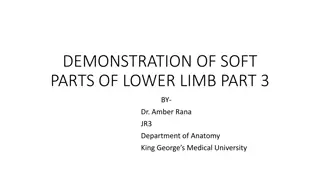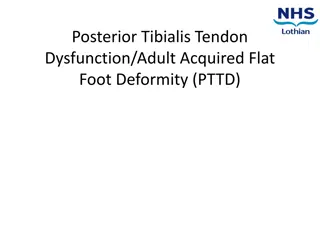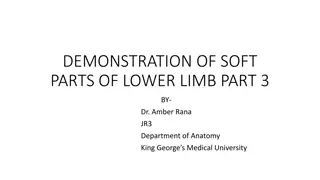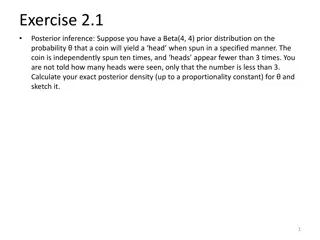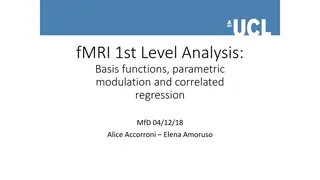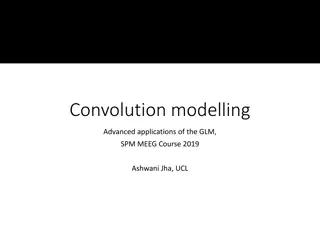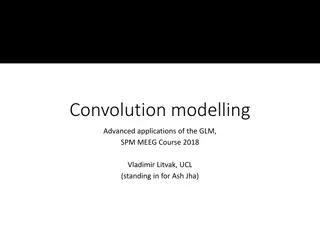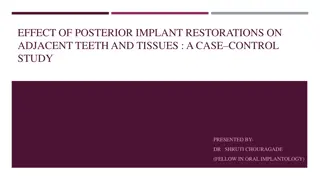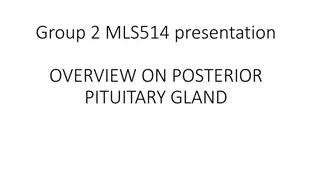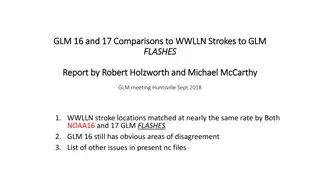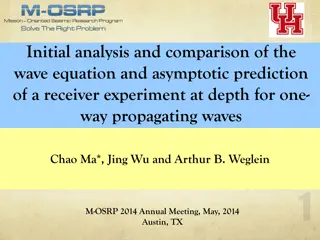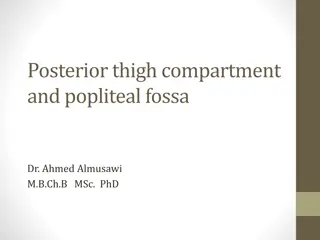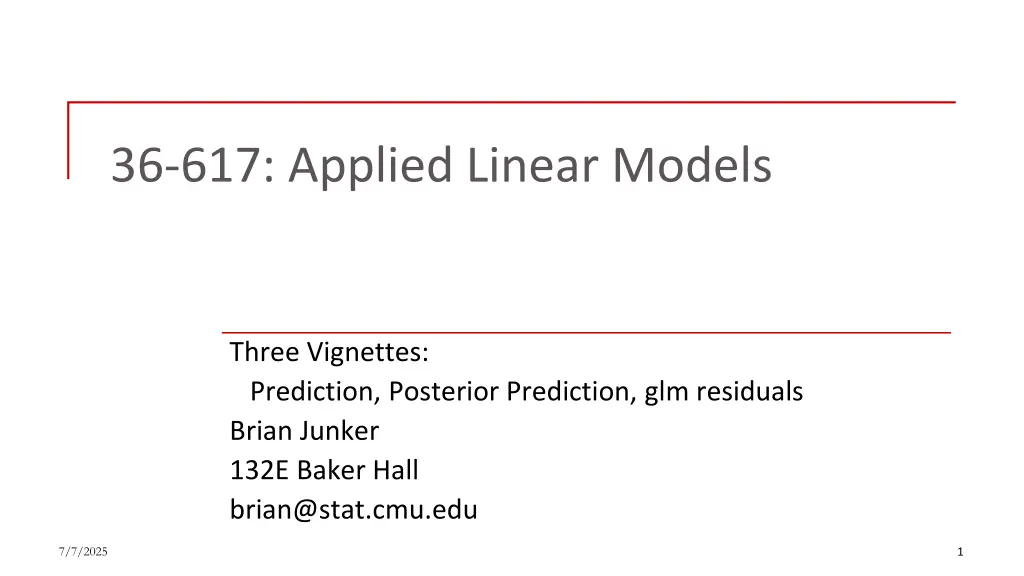
Linear Models Prediction Vignettes
Explore prediction techniques using linear models in R, including lm, glm, and stan. Learn about estimating and predicting with examples. Dive into posterior prediction and assessing model fit along with fixing glm residuals using stan.
Download Presentation

Please find below an Image/Link to download the presentation.
The content on the website is provided AS IS for your information and personal use only. It may not be sold, licensed, or shared on other websites without obtaining consent from the author. If you encounter any issues during the download, it is possible that the publisher has removed the file from their server.
You are allowed to download the files provided on this website for personal or commercial use, subject to the condition that they are used lawfully. All files are the property of their respective owners.
The content on the website is provided AS IS for your information and personal use only. It may not be sold, licensed, or shared on other websites without obtaining consent from the author.
E N D
Presentation Transcript
36-617: Applied Linear Models Three Vignettes: Prediction, Posterior Prediction, glm residuals Brian Junker 132E Baker Hall brian@stat.cmu.edu 7/7/2025 1
Announcements Peer Reviews (Due Fri 1159pm) Reviews should be collegial and helpful. Point out things the paper is doing right, and suggestions for improvement. Write in the rubric categories provided, but do not assign points Reading (in HW10 & weeks 13 & 14 folders on Canvas) Lynch, Ch 3 (read), Ch 4 (skim) Lynch, Ch 9 (read) HW10 (Due Wed Dec 7, 1159pm) Just some finger exercises so you can play with estimating multilevel models with Stan, examining Stan output, etc. Last Quiz (Mon-Tue Dec 5-6) Like midsemester survey your thoughts about the class. 7/7/2025 2
Outline Vignette 1: Prediction Review: Prediction with lm() Prediction with glm() Prediction with stan() Vignette 2: Posterior Prediction & Assessing Model Fit Posterior Predictive Distribution If the model fits well, the real data should be indistinguishable from data simulated from the model Vignette 3: Residuals for glm s Fixing glm residuals using stan() [Bayes] or library(DHARMa) [glm/glmer] 7/7/2025 3
Prediction For ordinary linear regression, we may be interested in Estimating ?[??|??] Predicting a new value ? at ?? Both are accomplished with the predict()function in R: predict(lm.1,interval= confidence ) gives a point estimate and CI for ? ???? the width for a 95% CI is 4 ??(? ????]) predict(lm.1,interval= prediction ) gives a point estimate and prediction interval for a new value ? at ?? ??(? ????])2+ ?2 the width for a 95% PI is 4 7/7/2025 4
Prediction with lm() ChickWeight data attach(ChickWeight) ## comes with R... lm.1 <- lm(log(weight) ~ Time*Diet + I(Time^2)*Diet) predictdata <- data.frame(weight=NA, Time=c(12,12,30,30), Diet=factor(c(1,2,1,2),levels=c(1,2,3,4))) pred.names <- c(" Time=12, Diet=1"," Time=12, Diet=2", " Time=30, Diet=1"," Time=30, Diet=2") pieces <- predict(lm.1,newdata=predictdata,se.fit=T) CI.se <- pieces$se.fit PI.se <- sqrt(pieces$se.fit^2 + pieces$residual.scale^2) CI <- predict(lm.1,newdata=predictdata, interval="confidence") row.names(CI) <- pred.names ; round(CI,2) ## fit lwr upr ## Time=12, Diet=1 4.64 4.60 4.69 ## Time=12, Diet=2 4.81 4.75 4.87 ## Time=30, Diet=1 5.48 5.22 5.73 ## Time=30, Diet=2 5.48 5.15 5.82 CI <- cbind(fit=pieces$fit, lwr=pieces$fit-2*CI.se,upr=pieces$fit+2*CI.se) row.names(CI) <- pred.names ; round(CI,2) ## fit lwr upr ## Time=12, Diet=1 4.64 4.60 4.69 ## Time=12, Diet=2 4.81 4.75 4.87 ## Time=30, Diet=1 5.48 5.22 5.73 ## Time=30, Diet=2 5.48 5.14 5.82 PI <- predict(lm.1,newdata=predictdata, interval="prediction") row.names(PI) <- pred.names ; round(PI,2) ## fit lwr upr ## Time=12, Diet=1 4.64 4.22 5.06 ## Time=12, Diet=2 4.81 4.39 5.23 ## Time=30, Diet=1 5.48 4.99 5.96 ## Time=30, Diet=2 5.48 4.95 6.02 PI <- cbind(fit=pieces$fit, lwr=pieces$fit-2*PI.se,upr=pieces$fit+2*PI.se) row.names(PI) <- pred.names ; round(PI,2) ## fit lwr upr ## Time=12, Diet=1 4.64 4.22 5.07 ## Time=12, Diet=2 4.81 4.38 5.24 ## Time=30, Diet=1 5.48 4.98 5.97 ## Time=30, Diet=2 5.48 4.94 6.02 detach() 5 7/7/2025
How does this work for glm()? The predict() function works for glm() fits But the interval argument no longer does anything! The se.fit argument is still there Based on experience with lm() predictions, se.fit=T probably returns ??(? ????]) We can use it for CI s for ? ????]but not for PI s for ? at ?? We can verify all this by fitting a stan() model with flat priors (so the results MLE results) and making predictions from the model 7/7/2025 6
Prediction with glm() Roach data roachdata <- read.csv("roachdata.csv",header=T) glm.1 <- glm(y ~ roach1 + treatment + senior, offset = log(exposure2), data = roachdata, family=poisson) predictdata <- data.frame(roach1=c(300,275,300,275), treatment=c(1,1,0,0), senior=rep(0,4), exposure2=rep(1,4), y=rep(NA,4)) pred.names <- c(" tx=1,roach1=300"," tx=1,roach1=275", " tx=0,roach1=300"," tx=0,roach1=275") pred.with.se <- predict(glm.1, newdata=predictdata,type="response", se.fit=T) intervals.from.predict <- with(pred.with.se, data.frame(lower=fit-2*se.fit, fit=fit, upper=fit+2*se.fit)) row.names(intervals.from.predict) <- pred.names round(intervals.from.predict,2) ## lower fit upper ## tx=1,roach1=300 101.16 106.42 111.68 ## tx=1,roach1=275 85.19 89.37 93.55 ## tx=0,roach1=300 170.51 178.42 186.32 ## tx=0,roach1=275 143.60 149.84 156.08 A good tip-off that these are CI s for ?[??|??], and not ? at ??, is that they are rather narrow The interval widths are 10-16 units Dividing by 4, the SE s are 2.5-4 But the SE s should be something like sqrt(fit) for Poisson data: round(sqrt(c(106.42,89.37,178.42,149.84)),2) [1] 10.32 9.45 13.36 12.24 7/7/2025 7
model { real loglambda[N]; for (i in 1:N) { loglambda[i] <- b0 + b_roach1*roach1[i] + b_treatment*treatment[i] + b_senior*senior[i] + offset[i]; y[i] ~ poisson_log(loglambda[i]); } b0 ~ normal(0,1e6); b_roach1 ~ normal(0,1e6); b_treatment ~ normal(0,1e6); b_senior ~ normal(0,1e6); } generated quantities { vector[5] beta; real y_pred[N_y_pred]; // number of rows in predictdata vector[N_y_pred] pred_loglambda; beta[1] <- b0; beta[2] <- b_roach1; beta[3] <- b_treatment; beta[4] <- b_senior; beta[5] <- 1; // for the offset pred_loglambda <- predictdata * beta; // mtx multiply! for (i in 1:N_y_pred) { y_pred[i] <- poisson_rng(exp(pred_loglambda[i])); } } Prediction with stan() We ll simulate fake data from a stan() model to explore this further This requires a new section in the stan() program, called generated quantities Each time new parameters are drawn from ?(??????|????): Dump them into vector beta log ????? = predictdata beta Simulate y_pred ?????(?????) The complete program is in stan_glm.1_text.stan 7/7/2025 8
Prediction with stan() We will focus on two matrices extracted from the stan() fit: stan.Ey.df <- exp(as.data.frame(stan_glm.1_results)[,paste0("pred_loglambda[",1:4,"]")] ) dim(stan.Ey.df) ; names(stan.Ey.df) <- paste0("E[y_",1:4,"]") ## [1] 1000 4 head(stan.Ey.df,3) // 1000 draws from the posteriors of E[y] for the 4 predictions we want ## E[y_1] E[y_2] E[y_3] E[y_4] ## 1 109.1745 91.61842 175.9811 147.6820 ## 2 104.4871 87.61899 180.0028 150.9437 ## 3 105.6540 88.56638 181.4256 152.0833 ## Etc. Etc. Etc. Etc. Etc. stan.y.df <- as.data.frame(stan_glm.1_results)[,paste0("y_pred[",1:4,"]")] dim(stan.y.df) ## [1] 1000 4 head(stan.y.df,3) // 1000 draws from the predictive distribution for the 4 predictions we want ## y_pred[1] y_pred[2] y_pred[3] y_pred[4] ## 1 96 86 166 141 ## 2 118 78 168 145 ## 3 107 75 166 139 ## Etc. Etc. Etc. Etc. Etc. 7/7/2025 9
Prediction with stan() stan.y.with.se <- data.frame(est=apply(stan.y.df,2,mean), sd=apply(stan.y.df,2,sd)) stan.y.intervals <- with(stan.y.with.se, data.frame( lower=est-2*sd, fit=est, upper=est+2*sd)) row.names(stan.y.intervals) <- pred.names round(intervals.from.predict,2) // from predict.glm ## lower fit upper ## tx=1,roach1=300 101.16 106.42 111.68 ## tx=1,roach1=275 85.19 89.37 93.55 ## tx=0,roach1=300 170.51 178.42 186.32 ## tx=0,roach1=275 143.60 149.84 156.08 round(stan.Ey.intervals,2) // from stan() ## lower fit upper ## tx=1,roach1=300 100.97 106.50 112.04 ## tx=1,roach1=275 85.05 89.45 93.85 ## tx=0,roach1=300 170.01 178.33 186.65 ## tx=0,roach1=275 143.21 149.77 156.33 round(stan.y.intervals,2) // from stan() ## lower fit upper ## tx=1,roach1=300 84.79 106.61 128.44 ## tx=1,roach1=275 70.30 90.01 109.72 ## tx=0,roach1=300 150.84 178.40 205.97 ## tx=0,roach1=275 123.34 149.77 176.20 stan_glm.1_data <- c(as.list(roachdata), list(N=dim(roachdata)[1], N_y_pred=4, predictdata=cbind("(Int)"=1, roach1=c(300,275,300,275), treatment=c(1,1,0,0), senior=rep(0,4), logexposure2=log(rep(1,4)) ) )) stan_glm.1_model <- stan(file="stan_glm.1_text.stan", data=stan_glm.1_data, chains=0) init_stan_glm.1 <- function(){ list(b0=rnorm(1), b_roach1=0.01*rnorm(1), b_treatment=rnorm(1), b_senior=rnorm(1)) } stan_glm.1_results <- stan(fit=stan_glm.1_model, data=stan_glm.1_data, init=init_stan_glm.1, chains=4, iter=500) stan.Ey.df <- exp(as.data.frame(stan_glm.1_results)[, paste0("pred_loglambda[",1:4,"]")] ) stan.Ey.with.se <- data.frame(est=apply(stan.Ey.df,2,mean), sd=apply(stan.Ey.df,2,sd) ) stan.Ey.intervals <- with(stan.Ey.with.se, data.frame( lower=est-2*sd, fit=est, upper=est+2*sd) ) row.names(stan.Ey.intervals) <- pred.names stan.y.df <- as.data.frame(stan_glm.1_results)[, paste0("y_pred[",1:4,"]")] Additional details in the file prediction-in-(g)lmer and stan.r 7/7/2025 10
Posterior Prediction Prediction is providing new values, ?????, based on the model and the data ?that we ve already seen. The distribution of these new values is the posterior predictive distribution: ? ??????= ? ??????,? ? ? ??? = ? ?????? ? ? ??? We can simulate ?????,? as follows, for ? = 1, ,?: Draw ?????,? ?(?|?), the posterior distribution Draw ?????,? ?(?????,?|?????,?), the likelihood evaluated at ?????,?. Then ?????,1, ,?????,? will be draws from ? ?????? We can explore the quality of our predictions by exploring ?????,1, ,?????,? 7/7/2025 11
Posterior Predictive Distribution transformed parameters { real loglambda[N]; for (i in 1:N) { loglambda[i] <- b0 + b_roach1*roach1[i] + b_treatment*treatment[i] + b_senior*senior[i] + offset[i]; } } model { for (i in 1:N) { y[i] ~ poisson_log(loglambda[i]); } b0 ~ normal(0,1e6); b_roach1 ~ normal(0,1e6); b_treatment ~ normal(0,1e6); b_senior ~ normal(0,1e6); } generated quantities { real y_pred[N]; for (i in 1:N) { y_pred[i] <- poisson_rng(exp(loglambda[i])); } } Generating a full replicate ????? of our original data ? is actually easier than generating the specific predictions in our previous example! Each time new parameters are drawn from ?(??????|????): Calculate log ? from them Use log ? to specify the likelihood Use log ? again to simulate y_pred ?????(?) The full stan() model is in stan_glm.1_ppd.stan 7/7/2025 12
Posterior predictive distribution Roach data stan_glm.1_ppd_data <- c(as.list(roachdata), list(N=dim(roachdata)[1])) The posterior predictive distribution can be used to assess model fit stan_glm.1_ppd_model <- stan(file="stan_glm.1_ppd.stan", data=stan_glm.1_ppd_data, chains=0) If the model fits well, the real data ? should look like it belongs with data ?????simulated from the model stan_glm.1_ppd_results <- stan(fit=stan_glm.1_ppd_model, data=stan_glm.1_ppd_data, init=init_stan_glm.1, chains=4, iter=1000) shinystan and bayesplot both can make graphical displays of simple posterior predictive checks of this proposition ## An earlier run with iter=500 had large rhats, ## suggesting it needed more iterations to converge to ## the stationary distribution. Examination with ## shinystan confirmed this; so, increased to iter=1000. y <- roachdata$y ## compare with y_pred in shinystan launch_shinystan(stan_glm.1_ppd_results) 7/7/2025 13
Using bayesplot for ppcs y <- roachdata$y yrep <- extract(stan_glm.1_ppd_results,pars="y_pred")$y_pred Nrep <- dim(yrep)[1] ; dim(yrep) ## [1] 2000 252 ## yrep has 2000 simulated replications of the data y g1 <- ppc_hist(y,yrep[sample(1:Nrep,3),]) g2 <- ppc_boxplot(y,yrep[sample(1:Nrep,11),]) g3 <- ppc_freqpoly(y,yrep[sample(1:Nrep,3),]) g4 <- ppc_dens(y,yrep[sample(1:Nrep,3),]) g5 <- ppc_dens_overlay(y,yrep[sample(1:Nrep,100),]) g6 <- ppc_ecdf_overlay(y,yrep[sample(1:Nrep,100),]) grid.arrange(g1,g2,g3,g4,g5,g6,ncol=2) 7/7/2025 14
Using bayesplot for ppc-based testing The real data gives the test statistic The tail probability is like a p-value The simulated yrep s give the null distribution g1 <- ppc_stat(y,yrep) ## default = mean g2 <- ppc_stat(y,yrep,stat="sd") zeros <- function(y) { sum(y==0) } g3 <- ppc_stat(y,yrep,stat=zeros) ones <- function(y) { sum(y==1) } g4 <- ppc_stat(y,yrep,stat=ones) fives <- function(y) { sum(y==5) } g5 <- ppc_stat(y,yrep,stat=fives) tens <- function(y) { sum(y==10) } g6 <- ppc_stat(y,yrep,stat=tens) grid.arrange(g1,g2,g3,g4,g5,g6,ncol=2) 7/7/2025 15
Doing a ppc by hand Need to do by hand if your ppc also involves parameters lambdarep <- exp(extract(stan_glm.1_ppd_results,pars="loglambda") $loglambda) dim(lambdarep) ## [1] 200 262 lambdahat <- apply(lambdarep,2,mean) dispersion <- function(y,lam,df) { sum((y-lam)^2/lam)/df } dispersion.obs <- dispersion(y,lambdahat,262-4) dispersion.rep <- NULL for (i in 1:Nrep) { dispersion.rep <- c(dispersion.rep, dispersion(yrep[i,],lambdarep[i,],262-4)) } hist(dispersion.rep) hist(dispersion.rep,xlim=c(0,dispersion.obs)) abline(v=dispersion.obs,col="red") text(x=dispersion.obs,y=10,label="dispersion.obs", cex=0.75,adj=c(1,0.8)) The simulated yrep s give the null distribution The real data gives the test statistic (test statistic) (null distrib.) The tail probability is like a p-value 2 ?? ?? ?? 2 under H0: no dispersion Ideally, ??? 7/7/2025 16
Fixing glm() residuals par(mfrow=c(2,2)) plot(glm.1) glm() residuals generated by R are hard to interpret Problems include: Discrete responses ? and range restrictions force curvilinear structure on residuals, even when the model fits The asymptotics for the CLT for residuals don t work well when ? can only take on a few discrete values Nonconstant variance is typical even when the model fits 7/7/2025 17
A potential solution to glm() residuals When the model fits, the residuals do have a well-defined distribution, even if it is not normal Use a posterior predictive simulation to get the (empirical) CDF ??? of that distribution Use the probability integral transform (PIT) ? = ??? to try to change the distribution of the residuals to the uniform distribution If the model fits well, then putting the real data residuals through the PIT based on replications from the model should make them look uniform If the model doesn t fit the real data well, there should be interpretable patterns in the transformed residuals PIT reminder: If ? ??? = ? ? ? , then we know ? = ??? ???? 0,1 7/7/2025 18
Details about this potential solution Let ??= ?? ?[??] / ???,?= ?? residuals of the ?? replication of simulated data ??( ? ??) be standardized residuals of the real data ???,? ? ?? ??( ? ?? ???,? / ???,?) be the standardized Let ?? ???,1, ,?1 ???,1, ,?2 ???,? to estimate ??1? , ???,? to estimate ??2? , etc. Use ?1 ?2 If the model fits well, then ??1?1, ??2?2, , ??????????? ????(0,1) 7/7/2025 19
The idea works, but its not very legible ecdf.rep <- function(r, r.rep) { val <- rep(NA,length(r)) for (i in 1:length(r)) { val[i] <- mean(r.rep[,i]<=r[i]) } return(val) } resid.obs <- (y - lambdahat)/sqrt(lambdahat) resid.rep <- (yrep - lambdarep)/sqrt(lambdarep) uniformed.resids <- ecdf.rep(resid.obs,resid.rep) reference.resids <- ecdf.rep(resid.rep[1,], resid.rep[-1,]) par(mfrow=c(3,1)) plot(resid.obs ~ lambdahat, main="Plain standardized residuals") plot(uniformed.resids ~ lambdahat, main="Real data residuals transformed to unif") plot(reference.resids ~ lambdarep[1,], main=paste("Reference: Simulated data residuals", "transformed to unif")) 7/7/2025 20
For Legibility: Replace raw log(?) with its ranks par(mfrow=c(3,1)) plot(resid.obs ~ rank(lambdahat), main="Plain standardized residuals") plot(uniformed.resids ~ rank(lambdahat), main= "Real data residuals transformed to unif") plot(reference.resids ~ rank(lambdarep[1,]), main=paste("Reference: Simulated data", "residuals transformed to unif")) 7/7/2025 21
For glm() and glmer(), its easier to use library(DHARMa) rather than library(rstan) library(DHARMa) ## vignette("DHARMa", package="DHARMa") ## is very helpful! testDispersion(simulationOutput) simulationOutput <- simulateResiduals(fittedModel = glm.1, plot = F) plot(simulationOutput) testZeroInflation(simulationOutput) 7/7/2025 22
Here is what the DHARMa plots look like when the model fits the data perfectly perfectmeans <- predict(glm.1,type="response") y.perfect <- rpois(length(y),perfectmeans) glm.1.perfect <- glm(y.perfect ~ roach1 + treatment + senior,offset=log(exposure2),data=roachdata, family=poisson) sim.result <- simulateResiduals(fittedModel=glm.1.perfect,plot=T) testDispersion(sim.result) testZeroInflation(sim.result) 7/7/2025 23
Summary Vignette 1: Prediction Review: Prediction with lm() Prediction with glm() Prediction with stan() Vignette 2: Posterior Prediction & Assessing Model FIt Posterior Predictive Distribution If the model fits well, the real data should be indistinguishable from data simulated from the model Vignette 3: Residuals for glm s Fixing glm residuals using stan() [Bayes] or library(DHARMa) [glm/glmer] 7/7/2025 24


